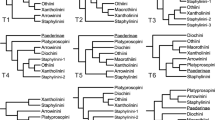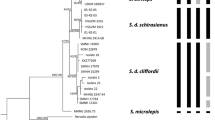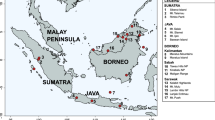Abstract
The phylogeny of flying squirrels was assessed, based on analyses of 80 morphological characters. Three published hypotheses were tested with constraint trees and compared with trees based on heuristic searches, all using PAUP*. Analyses were conducted on unordered data, on ordered data (Wagner), and on ordered data using Dollo parsimony. Compared with trees based on heuristic searches, the McKenna (1962) constraint trees were consistently the longest, requiring 8–11 more steps. The Mein (1970) constraint trees were shorter, requiring five to seven steps more than the unconstrained trees, and the Thorington and Darrow (2000) constraint trees were shorter yet, zero to one step longer than the corresponding unconstrained tree. In each of the constraint trees, some of the constrained nodes had poor character support. The heuristic trees provided best character support for three groups, but they did not resolve the basal trichotomy between a Glaucomys group of six genera, a Petaurista group of four genera, and a Trogopterus group of four genera. The inclusion of the small northern Eurasian flying squirrel, Pteromys, in the Petaurista group of giant South Asian flying squirrels is an unexpected hypothesis. Another novel hypothesis is the inclusion of the genus Aeromys, large animals from the Sunda Shelf, with the Trogopterus group of smaller "complex-toothed flying squirrels" from mainland Malaysia and southeast Asia. We explore the implications of this study for future analysis of molecular data and for past and future interpretations of the fossil record.
Similar content being viewed by others
LITERATURE CITED
Allen, G. M. (1940). The mammals of China and Mongolia, American Museum of Natural History, New York. 11(2): 621–1350.
Black, C. C. (1963). A review of the North American Tertiary Sciuridae. Bull. Mus. Comp. Zoo., Harvard University 130(3): 100–248.
Black, C. C. (1972). Holarctic evolution and dispersal of squirrels (Rodentia: Sciuridae). Evol. Bio. 6: 305–322.
Brandt, J. F. (1855). Beitrage zur nahern Kenntniss der Saugethiere Russland's. Memoires Acad. Sci. St Petersb. 9(1): 1–365.
Bremer, K. (1994). Branch support and tree stability. Cladistics 10: 295–304.
Bruijn, H. de, and Uenay, E. (1989). Petauristinae (Mammalia, Rodentia) from the Oligocene of Spain, Belgium, and Turkish Thrace. Ser. Nat. Hist. Mus., Los Angeles County 33: 139–145.
Bryant, M. D. (1945). Phylogeny of Nearctic Sciuridae. The American Midland Naturalist 33: 257–390.
Corbet, G. B., and Hill, J. E. (1986). A World List of Mammalian Species. 2ndEdition, British Museum (Natural History), London.
Corbet, G. B., and Hill, J. E. (1992). Mammals of the Indomalayan Region, Oxford University Press, New York.
Cuvier, F. (1825). Sciuroptère. Mém. Mus. Hist. Nat. X, pl. x fig. 5. 126–128.
Cuvier, G. (1800). Le¸cons d'anatomie comparée, vol. 1. Paris.
Dieterlen, F. (1993). Family Anomiluridae. In: Mammal Species of the World: A Taxonomic and Geographic Reference, Second ed., D. E. Wilson and D. M. Reeder, eds., pp. 419–465, Smithsonian Institution Press, Washington, D. C.
Ellerman, J. R. (1940). The Families and Genera of Living Rodents, British Museum (Natural History), London.
Ellerman, J. R. (1947). A key to the Rodentia inhabiting India, Ceylon, and Burma, based on collections in the British Museum. Part I. J. Mammal. 28: 249–278.
Ellerman, J. R. (1961). The Fauna of India, Mammalia (2nd ed., vol. 3, Rodentia). Dehli. (2 vols).
Ellerman, J. R., and Morrison-Scott, T. C. S. (1951). Checklist of Palaearctic and Indian Mammals 1758 to 1946, British Museum (Natural History), London.
Emry, R. J., and Korth, W. W. (1996). A new genus of squirrel (Sciuridae: Rodentia) from the Chadronian of western North America. J. Vert. Paleont. 16: 775–780.
Emry, R. J., and Korth, W. W. (2001). Douglassciurus, new name for Douglassia Emry and Korth, 1996, not Douglassia Bartsch, 1934. J. Vert. Paleont. 21(2): 400.
Emry, R. J., and Thorington, R. W., Jr. (1982). Descriptive and comparative osteology of the oldest fossil squirrel, Protosciurus (Rodentia: Sciuridae). Smithsonian Contrib. Paleobiology 47: 1–35.
Felsenstein, J. (1985). Confidence limits on phylogenies: An approach using the bootstrap. Evolution 39: 783–791.
Fleming, J. (1822). The Philosophy of Zoology; or A General View of the Structure, Functions, and Classification of Animals, Archibald Constable and Co., Edinburgh.
Groves, C. P. (1993). Order Diprotodontia. In: Mammal Species of the World: A Taxonomic and Geographic Reference, Second ed., D. E. Wilson and D. M. Reeder, eds., pp. 419–465, Smithsonian Institution Press, Washington, D. C.
Heude, P. M. (1898). Capricornes de Moupin, etc. Mémoires Hist. Nat. Emp. Chin. 4(1,2): 1–111, pls i-xxii.
Hight, M. E., Goodman, M., and Prychodko, W. (1974). Immunological studies of the Sciuridae. Systematic Zoology 23: 12–25.
Hoffmann, R. S., Anderson, C. G., Thorington, R. W., Jr., and Heaney, L. R. (1993). Family Sciuridae. In: Mammal Species of the World: A Taxonomic and Geographic Reference, Second ed., D. E. Wilson and D. M. Reeder, eds., pp. 419–465, Smithsonian Institution Press, Washington, D. C.
Howell, A. H. (1915). Descriptions of a new genus and seven new races of flying squirrels. Proc. Biol. Soc. Washington 28: 109–114.
Link, H. F. (1795). Beitrage zur Naturgeschichete. Band 1, Stuck 2. Ueber die Lebenskrafte in naturhistorisher Rucksicht und die Klassification der Saugethiere, Rostock and Leipzig.
Linnaeus, C. (1758). Systema naturae... vol. 1, 10th ed. Holmia.
McKenna, M. C. (1962). Eupetaurus and the living Petauristine Sciurids. Amer. Mus. Novit. 2104: 1–38.
McKenna, M. C., and Bell, M. (1997). Classification of Mammals Above the Species Level, Columbia University Press, New York.
Major, C. J. Forsyth (1893). On some Miocene squirrels, with remarks on the dentition and classification of the Sciurinae. Proceedings of the General Meetings for Scientific Business of the Zoological Society of London 1893: 179–215. Pl VIII-XI.
Mein, P. (1970). Les sciuroptères (Mammalia, Rodentia) néogènes d'Europe occidentale. Geobios 3: 7–77.
Miller, G. S. (1912). Catalogue of the Mammals of Western Europe (Europe Exclusive of Russia) in the Collection of the British Museum, British Museum (Natural History), London.
Miller, G. S. (1914). Generic name of the common flying squirrels. Proc. Biol. Soc. Washington 27: 216.
Oshida, T., Lin, L-K., Yanagawa, H., Endo, H., and Masuda, R. (2000). Phylogenetic relationships among six flying squirrel genera, inferred from mitochondrial cytochrome b gene sequences. Zoological Science 17: 485–489.
Pallas, P. S. (1778). Novae species quadrupedum e glirum ordine... Walther, Erlangae.
Pocock, R. I. (1923). The classification of the Sciuridae. Proc. Zool. Soc. London, 1923: 209–246.
Robinson, H. C., and Kloss, C. B. (1915). Aeromys, a new genus of flying squirrel. J. Fed. Malay St. Mus. 6: 23.
Saha, S. S. (1981). A new genus and a new species of flying squirrel...from northeastern India. Bull. Zool. Surv. India 4: 331–336.
Simpson, G. G. (1945). The principles of classification and a classification of the mammals. Bull. Amer. Mus. Nat. Hist. 85: xvi, 350pp.
Thomas, O. (1888). Eupetaurus, a new form of flying squirrel from Kashmir. J. Asiat. Soc. Bengal 57(2): 256–260.
Thomas, O. (1896). On the genera of rodents: An attempt to bring up to date the current arrangement of the order. Proc. Zool. Soc. London. 1012–1016.
Thomas, O. (1908). The genera and subgenera of the Sciuropterus group, with descriptions of three new species. Annals and Magazine of Natural History Series 8, Vol. 1:1–8.
Thorington, R. W., Jr. (l984). Flying squirrels are monophyletic. Science 225: 1048–1050.
Thorington, R. W., Jr., and Darrow, K. (2000). Anatomy of the squirrel wrist: Bones, ligaments, and muscles. J. Morphol. 246: 85–102.
Thorington, R. W., Jr. and Heaney, L. R. (1981). Body proportions and gliding adaptations of flying squirrels (Petauristinae). J. Mammal. 62(1): 101–114.
Thorington, R. W., Jr., Musante, A. L., Anderson, C. G., and Darrow, K. (1996). The validity of three genera of flying squirrels: Eoglaucomys, Glaucomys, and Hylopetes. J. Mammal. 77: 69–83.
Thorington, R. W., Jr., Darrow, K., and Betts, A. D. K. (1997). Comparative myology of the forelimb of squirrels (Sciuridae). J. Morphol. 234: 155–182.
Thorington, R. W., Jr., Darrow, K., and Anderson, C. G. (1998). Wingtip anatomy and aerodynamics in flying squirrels. J. Mammal. 79: 245–250.
Wilson, D. E. (1993). Family Dermoptera. In: Mammal Species of the World: A Taxonomic and Geographic Reference, Second ed., D. E. Wilson and D. M. Reeder, eds., pp. 419–465, Smithsonian Institution Press, Washington, D. C.
Author information
Authors and Affiliations
Corresponding author
Rights and permissions
About this article
Cite this article
Thorington, R.W., Pitassy, D. & Jansa, S.A. Phylogenies of Flying Squirrels (Pteromyinae). Journal of Mammalian Evolution 9, 99–135 (2002). https://doi.org/10.1023/A:1021335912016
Issue Date:
DOI: https://doi.org/10.1023/A:1021335912016




